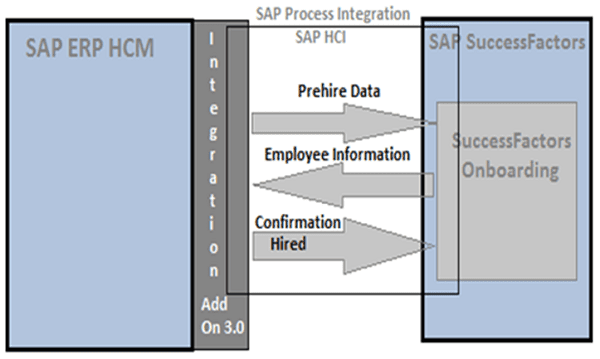What is SAP SuccessFactors?
SAP SuccessFactors is a cloud-based HR solution for organizations.
This business solution is based on Software as a Service (SaaS) model.
The tool is designed to meet the requirement of enterprise-class
organizations. It also helps you to improve business execution and get
better results.
Key Features of SAP SuccessFactors
Here are essential features of SAP SuccessFactors software:
-
Offers comprehensive HCM suite
-
Global expertise
-
Allows recruitment HR transactions
-
Changes and transfers position
-
Helps you in the management of time off
-
Payroll timesheets reporting
-
Compliance and auditing integration
-
Crud operations on all SuccessFactors objects
-
Allows you to perform queries at the planned time
-
Allows extensible learning and development
History of SAP SuccessFactors
Here are some important landmarks of the history of SAP
SuccessFactors:
-
Lars Dalgaard founded SuccessFactors in 2001
-
In November 2007, the company became public on the NASDAQ global market under the stock symbol SFSF.
-
SuccessFactors was acquired by SAP and became SAP SuccessFactors in 2011.
-
In, the year October 2013, SAP SuccessFactors has become an internal part of the SAP online Cloud Platform.
-
In, December 2013, SuccessFactors had more than 600 customers with 11.5 million users.
-
In 2015, the company started offering features like total workforce management, time, and attendance management.
-
In, 2018, SAP Builds New HR Community with Simple Solutions to Big Problems.
-
In, 2019 it offers features that Strengthened connectivity to SAP S/4HANA.
SAP SuccessFactors – Architecture
SAP SuccessFactor helps companies to manage HR functions in the
cloud environment effectively. This cloud computing solution helps
you to integrate to SAP ERP using SAP HCI or SAP PI. However, most
of the clients in SuccessFactors don't prefer integration with SAP
ERP solution.
For that, you can use two middleware to implement integration
between On-premise and Cloud environment.
SAP ERP:
SAP ERP system allows users to run their business processes,
which includes sales, accounting, production, human resources,
and finance, in a single integrated environment.
HANA Cloud Integration
SAP HCI is used to implement the integration of business
processes and data between cloud and on-premise solution. It
helps you to integrate business processes between various
organizations. It also used for business units of the same
organization.
SAP HANA Cloud Integration helps you to implement various
business processes like synchronization, etc. Using SAP HCI
perform ETL function Extract-Transform- Load between your
on-premise and cloud system.
Moreover, you can also use Eclipsed based integration that
helps you to perform mapping of various business operations.
It also allows you to messages and set up those on SAP HCI
platform.
SAP Process Integration ( PI)
SAP Process Integration helps you to process easy integration
between SAP and non-SAP application. It also allows integration
with a system on an organization outside any organization.
SAP SuccessFactors - Integration Factors
SAP SuccessFactors uses Integration add-on allows you to
perform data integration between two environments, which
are:
-
SAP ERP HCM
-
SuccessFactors HCM
However, the final selection depends upon an organizational
structural data, qualification data, and compensation.
Let's learn about all these factors:
Compensation Data:
Compensation Data process helps you to transfer data from SAP
ERP HCM to SuccessFactors. This helps you to transfer planned
data.
Employee Data:
Helps you to transfer employee and company-related data from
SAP ERP HCM into SuccessFactors. This factor helps you to
manage the Talent Management process in SuccessFactors.
Evaluation of Data:
After, this process employee pre-hire data should be exported
from the HCM suite to SuccessFactor. After that, it is
extracted, and information will be sent to
SuccessFactors.
Lastly, all the important and exported data is stored in
various stages, and with the use of Transaction. This helps
you to move the data to the employee master.
Benefits of Using SAP success factors
Here are some essential pros/ advantages of using SAP
success factors.
-
Offers scalability and allows an unlimited extensibility
-
Provides the complete end-to-end recruiting solutions
-
Performance and Goals module is the easiest way to track and maintain professional and personal goals.
-
SAP SuccessFactors makes onboarding a planned process which helps any organization to increase their job satisfaction, time to productivity
-
It helps the organization to motivate their workforce to perform at their best and produce an exact pay-for-performance culture.
-
It offers performance management and smoother compensation.
-
It allows you to create a policy which includes learning management solutions.
Challenges while working with SAP success factors
Here are cons/drawback of working with SAP success
factors.
-
Cost of implementing SAP SuccessFactors is quite high.
-
They should offer better online training and support.
-
Functionality, but customization is quite a challenge.
-
In SAP SF manager reports feature is only available if you pay for them
-
Almost 90% of the product's features are not very useful.
Summary:
-
SAP SuccessFactors is a cloud-based HR solution for your business
-
Offers comprehensive HCM suite
-
Lars Dalgaard founded SuccessFactors in 2001
-
Compensation Data process helps you to transfer data from SAP ERP HCM to SuccessFactors.
-
Helps you to transfer employee and company-related data from SAP ERP HCM into SuccessFactors
-
Employee Data process employee pre-hire data should be exported from the HCM suite to Success Factor.
-
SAP Success factor helps companies to manage HR functions in the cloud environment effectively
-
It offers scalability and allows unlimited extensibility.
-
The biggest challenges of using SAP SuccessFactors is that the cost of implementing SAP SuccessFactors is quite high.
For SAP HCM Course content details please Click Here
For SAP SuccessFactors Course content details please Click Here
List of SAP Course content details please Click Here
For SAP SuccessFactors Course content details please Click Here
List of SAP Course content details please Click Here








